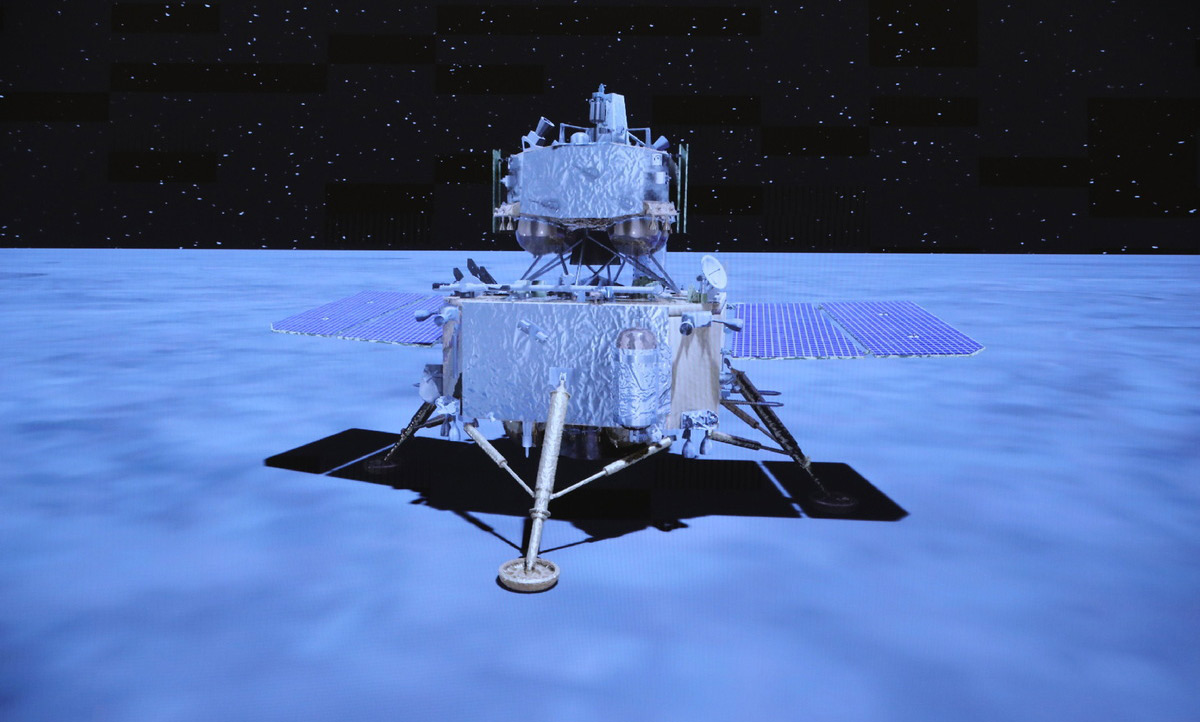


A photo taken at the Beijing Aerospace Control Center (BACC) shows the China's Chang'e 5 robotic lunar probe landing on the moon, Dec 2, 2020. (Photo/Xinhua)
BEIJING, Dec. 17 (Xinhua) -- The return capsule of China's Chang'e-5 probe touched down on Earth in the early hours of Thursday, bringing back the country's first samples collected from the moon.
It marks a successful conclusion of China's three-step lunar exploration program of orbiting, landing and bringing back samples, which began in 2004.
The following are some key facts about China's lunar exploration.
PREPARATION
-- In 1998, the Commission for Science, Technology and Industry for National Defense began planning the lunar mission, tackling major scientific and technological problems.
-- In 2004, the lunar orbiter project was formally established, and the mission was named "Project Chang'e" after the mythical Chinese goddess who flew to the moon.
CHANG'E-1
-- On Oct. 24, 2007, China launched Chang'e-1, its first lunar probe, making China the fifth country to develop and launch a lunar probe on its own.
-- Orbiting 200 km above the moon, Chang'e-1 mapped 3D images of the lunar surface, analyzed the distribution of elements, measured the depth of lunar soil, and explored the environment between Earth and the moon.
-- On March 1, 2009, Chang'e-1 made a controlled crash on the lunar surface after orbiting the moon for about 16 months.
CHANG'E-2
-- On Oct. 1, 2010, Chang'e-2 was sent into space. It took pictures of Sinus Iridium, or the Bay of Rainbows, the proposed landing site of the Chang'e-3.
-- On April 1, 2011, Chang'e-2 completed all six engineering objectives and four scientific missions. Its design lifetime expired.
-- On Dec. 13, 2012, Chang'e-2, in deep space 7 million km away from Earth, flew by and surveyed the Toutatis asteroid. It then continued into deep space, becoming a man-made asteroid in the solar system.
CHANG'E-3
-- On Dec. 2, 2013, China launched the Chang'e-3 probe with its first moon rover aboard.
-- On Dec. 14, 2013, Chang'e-3 landed on the moon, marking the first time that China has sent a spacecraft to soft land on the surface of an extraterrestrial body.
-- The Chang'e-3 included a lander and a moon rover called Yutu (Jade Rabbit), which took photos of each other. The probe acquired a geological profile of the moon, and discovered a new kind of lunar rock.
TEST CRAFT FOR CHANG'E-5
-- On Oct. 24, 2014, China launched an experimental spacecraft, comprising a re-entry capsule and a service module, to test technologies to be used on Chang'e-5.
-- On Nov. 1, 2014, the return capsule touched down at the designated landing area in Siziwang Banner, north China's Inner Mongolia Autonomous Region.
-- The service module flew back to orbit the moon for further tests and reached the L2 point of the Earth-Moon system to conduct experiments.
CHANG'E-4
-- On May 21, 2018, China launched a relay satellite named Queqiao (Magpie Bridge) to set up a communication link between Earth and the moon's far side.
-- The Chang'e-4 probe, launched on Dec. 8, 2018, made the first-ever soft landing on the Von Karman Crater in the South Pole-Aitken Basin on the far side of the moon on Jan. 3, 2019.
-- Chang'e-4 includes a lander and a moon rover called Yutu-2, or Jade Rabbit-2. The rover Yutu-2 has far exceeded its three-month design lifespan, becoming the longest-working lunar rover on the moon. As of Nov. 23, Yutu-2 has traveled 589.6 meters on the moon.
CHANG'E-5
-- On Nov. 24, China launched the Chang'e-5 probe that comprises an orbiter, a lander, an ascender and a returner.
-- On Dec. 1, the lander-ascender combination of Chang'e-5 successfully landed on the near side of the moon and started sampling.
-- On Dec. 3, the ascender of Chang'e-5 took off from the lunar surface and entered the preset lunar orbit with lunar samples.
-- On Dec. 6, the ascender successfully rendezvoused and docked with the orbiter-returner combination in lunar orbit, and transferred the samples to the returner.
-- On Dec. 17, the returner of the Chang'e-5 probe separated from the orbiter and successfully landed in Siziwang Banner, Inner Mongolia Autonomous Region.

 Award-winning photos show poverty reduction achievements in NE China's Jilin province
Award-winning photos show poverty reduction achievements in NE China's Jilin province People dance to greet advent of New Year in Ameiqituo Town, Guizhou
People dance to greet advent of New Year in Ameiqituo Town, Guizhou Fire brigade in Shanghai holds group wedding
Fire brigade in Shanghai holds group wedding Tourists enjoy ice sculptures in Datan Town, north China
Tourists enjoy ice sculptures in Datan Town, north China Sunset scenery of Dayan Pagoda in Xi'an
Sunset scenery of Dayan Pagoda in Xi'an Tourists have fun at scenic spot in Nanlong Town, NW China
Tourists have fun at scenic spot in Nanlong Town, NW China Harbin attracts tourists by making best use of ice in winter
Harbin attracts tourists by making best use of ice in winter In pics: FIS Alpine Ski Women's World Cup Slalom
In pics: FIS Alpine Ski Women's World Cup Slalom Black-necked cranes rest at reservoir in Lhunzhub County, Lhasa
Black-necked cranes rest at reservoir in Lhunzhub County, Lhasa China's FAST telescope will be available to foreign scientists in April
China's FAST telescope will be available to foreign scientists in April